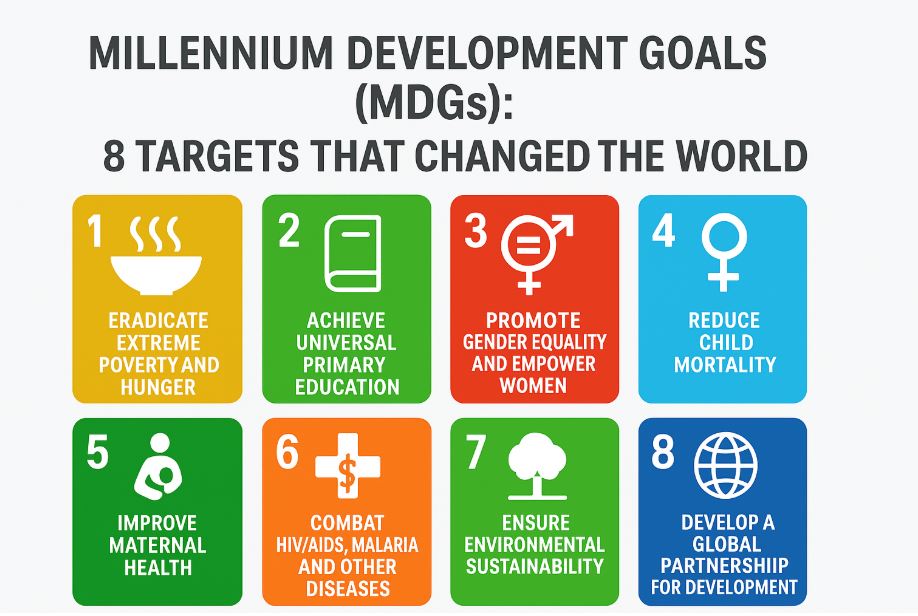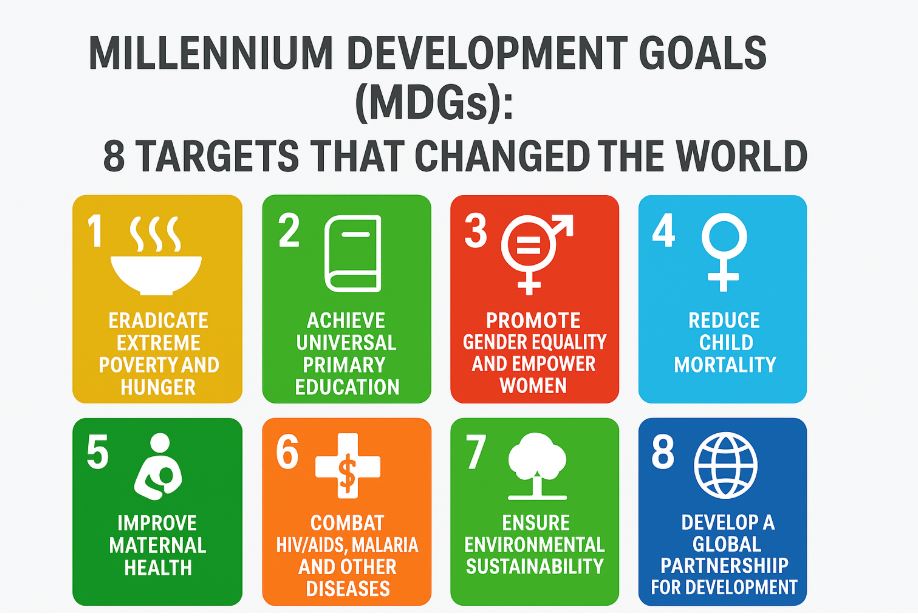Millennium Development Goals (MDGs):

Introduction: A Global Promise to End Poverty and Inequality
In the year 2000, world leaders gathered at the United Nations and signed a bold pact to make the world fairer, healthier, and safer. This pact became the Millennium Development Goals (MDGs) — eight time-bound targets to tackle poverty, hunger, disease, gender inequality, and environmental degradation by 2015. For the first time, 191 countries agreed to a common framework for action, making MDGs one of the most ambitious development efforts in history. These goals not only changed how governments, NGOs, and international agencies measured progress but also paved the way for today’s Sustainable Development Goals (SDGs). Let’s explore what the MDGs were, what they achieved, and why they still matter.
What Are Millennium Development Goals (MDGs)?
The Millennium Development Goals were adopted at the UN Millennium Summit in September 2000. They provided a global blueprint for development, with a deadline of 2015. Their focus was on improving living standards, promoting human rights, and building international partnerships. Unlike earlier UN declarations, the MDGs had clear, measurable targets and indicators — a big shift from vague promises to concrete action.
The 8 Millennium Development Goals Explained
Below is a breakdown of the eight MDGs with short explanations:

1. Eradicate Extreme Poverty and Hunger
Halve the proportion of people living on less than $1.25 a day and reduce hunger by improving access to food, employment, and basic needs.
2. Achieve Universal Primary Education
Ensure that every child — boys and girls alike — completes primary schooling by 2015.
3. Promote Gender Equality and Empower Women
Eliminate gender disparity in education and boost women’s participation in decision-making, jobs, and political leadership.
4. Reduce Child Mortality
Cut under-five mortality rates by two-thirds through better immunization, nutrition, and healthcare.
5. Improve Maternal Health
Reduce maternal mortality by three-quarters and provide universal access to reproductive healthcare.
6. Combat HIV/AIDS, Malaria, and Other Diseases
Reverse the spread of major diseases through prevention, treatment, and public awareness campaigns.
7. Ensure Environmental Sustainability
Integrate sustainable development into national policies, protect natural resources, and improve access to safe drinking water and sanitation.
8. Develop a Global Partnership for Development
Build a fairer global trading and financial system, address the needs of least developed countries, and make essential drugs affordable.(Tip: Insert a colorful infographic of these 8 goals here for visual engagement.)
Achievements of the Millennium Development Goals
While not every target was fully met, the MDGs sparked historic progress:
- Poverty Reduction: The share of people living in extreme poverty fell from 36% in 1990 to 12% in 2015.
- Education Gains: Primary school enrollment in developing regions rose to 91% by 2015, with gender parity improving dramatically.
- Health Improvements: Global under-five mortality dropped by more than half. Maternal deaths declined by 45%. Millions gained access to HIV treatment.
- Clean Water Access: 2.6 billion people gained access to improved drinking water sources.
These achievements show that global cooperation and measurable targets can produce real change.
Challenges and Criticism of the MDGs
Despite successes, the MDGs faced criticism:
- Uneven Progress: Sub-Saharan Africa lagged behind in several indicators, especially maternal health.
- Narrow Focus: Some argued the goals ignored issues like inequality within countries, human rights, and climate change adaptation.
- Data Gaps: Many developing nations lacked reliable statistics, making it hard to measure progress accurately.
Still, the MDGs transformed development thinking by introducing accountability and timelines.
From MDGs to SDGs: The Next Chapter
In 2015, the MDGs expired and were replaced by the Sustainable Development Goals (SDGs) — a broader agenda with 17 goals and 169 targets to be achieved by 2030. Where MDGs focused mainly on developing countries, SDGs apply to all nations and cover interconnected issues like climate action, innovation, and peace. The SDGs build on the MDGs’ successes while addressing their shortcomings, such as inequality, environmental protection, and governance.(Tip: Add a comparison table — MDGs vs. SDGs — for readers to quickly see the differences.)
Why Millennium Development Goals Still Matter Today
Even though the MDGs officially ended in 2015, their impact lives on:
- They showed the power of global partnerships and measurable targets.
- They inspired governments to prioritize health, education, and poverty eradication.
- They created a foundation for the 2030 Agenda for Sustainable Development.
Understanding MDGs helps readers see why SDGs are designed the way they are — and how future global initiatives can succeed.
Actionable Tips for Students & Bloggers
If you’re a student, teacher, or blogger:
- Use MDGs as case studies in development or political science assignments.
- Compare your country’s progress on MDGs with regional averages.
- Create infographics or timelines for social media posts to raise awareness.
These tactics make the MDGs not just history, but a tool for learning and advocacy.
Frequently Asked Questions (FAQs)
1. What are the Millennium Development Goals (MDGs)?
They are eight UN targets launched in 2000 to fight poverty, hunger, disease, and inequality, with a deadline of 2015.
2. How are MDGs different from SDGs?
MDGs had 8 goals focused on developing countries; SDGs have 17 goals applicable to all countries, with a broader agenda for 2030.
3. Did the MDGs succeed?
Partly. Extreme poverty and child mortality dropped significantly, but progress was uneven and some goals were unmet.
4. Why were MDGs important for global development?
They provided a measurable framework for governments and NGOs, improved data collection, and mobilized billions in aid.
5. How can I use MDGs in my studies or blog?
Discuss them in assignments, compare your country’s progress, or explain how they evolved into SDGs to educate your audience.
Conclusion: The Legacy of the MDGs
The Millennium Development Goals were a milestone in global cooperation. They transformed development from vague aspirations into concrete, measurable actions. While not perfect, they cut poverty, improved health and education, and set the stage for the Sustainable Development Goals.
Call to Action:
If you found this article helpful, share it with your friends, comment below with your thoughts on global development, and explore our guide on Sustainable Development Goals (SDGs) to see how the world is continuing the MDG journey.